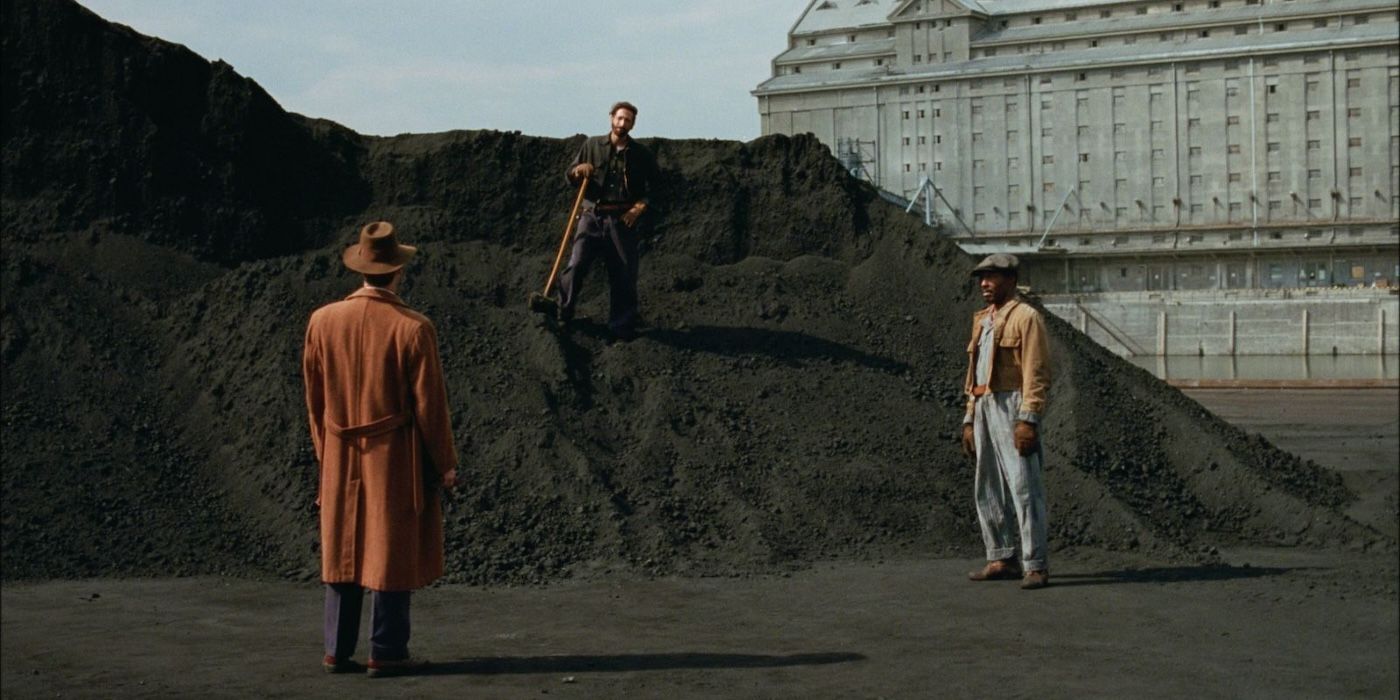When watching classic films like Citizen Kane, Lawrence of Arabia, or even a modern gem like There Will Be Blood or Oppenheimer, grand epics that focus on the accomplishments of great men with gargantuan ambitions, it’s easy to think, “They rarely make movies like this nowadays.” That’s also the feeling one gets when watching Brady Corbet’s third film as director, The Brutalist, a 215-minute movie, complete with an opening musical overture and an intermission, shot on VistaVision, a film format that has rarely been used since the 1950s. Yet Corbet’s film, which he co-wrote with filmmaker, actress, and his wife, Mona Fastvold, manages to be both a throwback to this type of expansive yet personal storytelling, while also being incredibly modern in its form and experimentation. It’s a movie that warrants this level of scope and grandiosity, an ambitious, towering achievement of a film, even when it stumbles in its second half.
What Is ‘The Brutalist’ About?
Adrien Brody gives a career-best performance as László Tóth, a Hungarian-Jewish survivor of the Holocaust who comes to America in the late 1940s. At home, László made a name for himself as an architect, leaving behind remarkable, striking pieces. László also came to America without his wife, Erzsébet Tóth (Felicity Jones), and his orphaned niece, Zsófia (Raffey Cassidy), but he writes to them, trying to convince them to join him in his new home. At first, László works with his cousin Attila (Alessandro Nivola), who owns a furniture shop in Philadelphia and for whom László makes some incredible pieces. But after crafting a tremendous library remodel for the wealthy Harrison Lee Van Buren (Guy Pearce) at his nearby mansion, Harrison contracts László to make the most massive, costly, and challenging building of his entire architectural career.
Throughout The Brutalist, it’s a delight to simply watch László work within his craft. As we watch the library remodel, commissioned by Harrison’s entitled son, Harry (Joe Alwyn), and his twin sister, Maggie (Stacy Martin), Corbet shows us the space, explains what the room’s complications are, and then we watch as László goes to solve these problems to make something truly stunning. Whether we’re watching him build a table for Attila’s shop, or undertaking Harrison’s enormous project, László’s talents are gripping to behold. In a film that can quite often be, as the name implies, brutal, watching the joy that László gets from showing off his gifts is often an all too brief respite for the uphill climb László must undertake to take part in the American dream.
‘The Brutalist’ Features Adrien Brody’s Finest Performance So Far
Brody is tremendous as László, an exceptional talent who wants to make his way in this new country and isn’t against working his way from the bottom to achieve his goals. As the film progresses, Brody shows László’s confidence building, a reminder of his past life, and an opportunity to showcase his abilities once more. The Brutalist is largely about an immigrant’s uphill climb in America and how exhausting the journey to prove yourself can be, and Brody embodies every one of these emotions perfectly. From the opening where he first steps off the ship to the last moments when we get to see his true vision, it’s an unforgettable performance that will go down as one of the year’s best.
It’s also fascinating to watch how László’s journey changes depending on who enters his world. When he lives in Attila’s furniture shop, holed up in an old stock room, he’s much more meek and unassuming; he gets his work done, but he mostly stays out of sight. Yet once he’s shown his greatness through old newspaper clips by Harrison and given a job worthy of his talents, he tackles the opportunity with vigor. Pearce is also giving one of his finest performances yet as Harrison, a symbol of how rich men in power utilize the work of immigrants to get ahead in life. Harrison isn’t a character who’s easy to parse out, shifting from a screaming madman to a welcoming figure in the community for László in his first two scenes. Even when The Brutalist is more blunt about Harrison’s intentions in the second half of the film, one of the movie’s rare missteps, Pearce plays Harrison with the stoicism and hypocritical moralism that makes the character work.
But there may be no bigger shift in The Brutalist than the one presented by Jones’ Erzsébet, and how her survival first fuels László’s quest, then challenges him in ways he didn’t expect. Jones’ Erzsébet is full of her own power, always ready to help and defend her husband, but also attempting to get back to normalcy and become a strong person on her own once more. While László almost becomes obsessed with Harrison’s project as the film goes on, Erzsébet has more chances to watch the Van Buren family without the burden of potential work looming over her. She can see the inconsistencies and questionable faces the family puts on while keeping an eye on the cracks underneath. Together, we can tell Erzsébet and László deeply love each other, but just because they’ve suffered greatly and come out the other end doesn’t mean that their problems have now washed away.
‘The Brutalist’ Starts Off Strong, but Occasionally Stumbles in Its Second Half
Corbet and Fasvold take this one man’s story and make it feel as magnificently epic as it deserves to be. Each frame is impeccably put together, with gorgeous cinematography by Corbet’s frequent collaborator Lol Crawley, and the entire story is strikingly impressive in the way its presented. Editor Dávid Janscó (Pieces of a Woman, The World to Come) has the unenviable task of compressing this character’s life into this timeframe, and the film gracefully knows when to let us linger in moments that need to take their time, but can fly through details that aren’t necessarily important to László’s tale. Again, this feels like an old-school classic, but with a modern sensibility that shows this couldn’t have been made at any other time.
Corbet and Fasvold, in just their third film together, are tackling a staggering amount of massive topics, such as the immigrant experience, the building of America post-war, and how our country is often defined by those who come to it looking for something better. For the most part, Corbet and Fasvold’s script beautifully handles these points with great care and consideration. But The Brutalist’s biggest flaws come in the occasional bumps in the screenplay, and some fairly heavy-handed imagery sprinkled throughout. In his post-screening Q&A at TIFF, Corbet discussed how he dislikes when films present their ideologies upfront and without letting the story make its points for itself. And yet, The Brutalist is also a film that begins with an immigrant coming to America, getting off the boat, and the first thing he sees is the Statue of Liberty upside down. It’s a striking image, for sure, but it also is exactly the type of shot that Corbet is apparently against.
While the first half of this film is gripping in its simplicity, as we watch László slowly climb the ladder back to the top, the second half understandably gets more complicated, and the screenplay itself has some issues with keeping up the quality. One of the most egregious examples, and most frustrating uses of straightforward symbolism, comes when László and Harrison go on a trip together to find materials for Harrison’s project. Without spoiling the details of the scene, Corbet and Fasvold choose to give us a scene that is far too blunt and direct in its presentation of how they believe the rich Americans treat the poor immigrants who come to our country. It’s a point that could’ve been made better in a more restrained way, but the film takes a direct route that feels out of place in the story we’ve been watching up until this point. Similarly, László has an addiction to heroin that he takes to dull the pain of a broken nose, and while these sequences are often harrowing, especially in the second half, they call a bit into cliché from time to time. Thankfully, these more conventional choices aren’t too common in a film that manages to feel fairly unconventional.
Corbet’s third film comes close to being a masterpiece, but not quite. Still, shows that the astounding filmmaker certainly has a masterpiece in him. It’s truly astonishing to see this type of scale and quality coming from a director so early in their career, and it’s exciting to see Corbet creating a film unlike anything coming out these days. The Brutalist often plays with themes and tones that we’ve seen before, but through his vision, it plays as something wholly original and unique. Corbet’s film also showcases the immense talents of everyone within the film, from Brody, Pearce, and Jones giving some of their best performances, to the stunning cinematography of Crawley that makes this personal story feel towering. Despite its occasional flaws, The Brutalist is one of the most remarkable films of the year, and proof that Corbet is a fascinating filmmaker to keep an eye on.
The Brutalist had its North American premiere at the Toronto International Film Festival.






